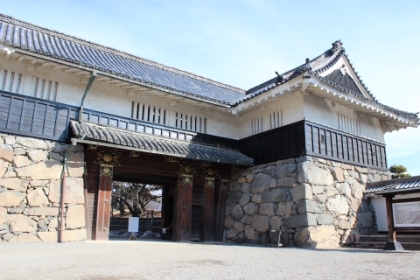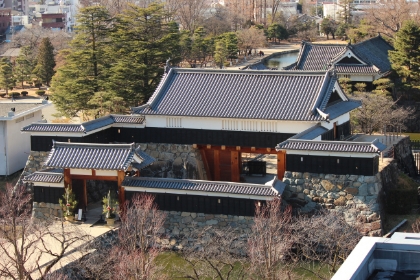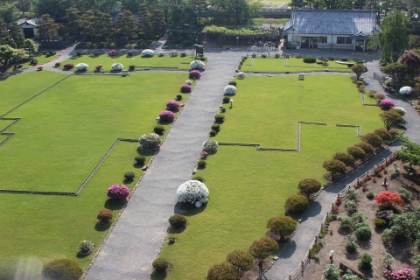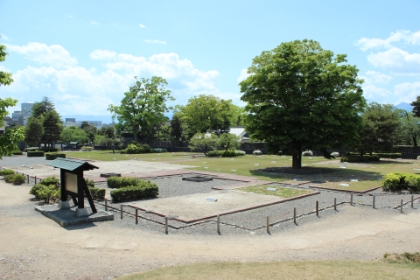Origin
The origin of Matsumoto Castle goes back to Fukashi Castle, which was built at the beginning of the Eisho Era, in the civil war period. During those troubled times, Lord Ogasawara in Shinano, moved his manor house from Igawa to the Hayashi district at the eastern foot of the mountain. At that time, the center of Matsumoto plain was called Shinano Fuchu. Lord Ogasawara's retainers protected themselves by building their houses around Hayashi Castle, the new manor house of their lord. Fukashi Castle was built in front of Hayashi Castle at around the same time to protect the front of the manor house. After that, Shingen Takeda of Kai chased away Lord Ogasawara to create a strongpoint for the conquest of Shinano. Then, in year 10 of the Tensho Era (1582), Sadayoshi Ogasawara recaptured Fukashi Castle by taking advantage of the protectors letting down their guard during the Honnoji incident. He then changed the name to Matsumoto Castle.
Construction of Tenshu
After Hideyoshi Toyotomi dominated the whole region by defeating Ujinao Hojo at Odawara Castle in year 18 of the Tensho Era (1590), he allocated the Kanto area to Ieyasu Tokugawa. Hidemasa Ogasawara, the lord of Matsumoto Castle at that time, also moved to Shimoosa in Kanto by following Ieyasu. Hideyoshi appointed Kazumasa Ishikawa as the new lord of Matsumoto Castle. Kazumasa and Yasunaga, the father and the son, maintained the castle and the town. Yasunaga built, not only the three towers, including the tenshu (donjon tower), inui-kotenshu (small tower in the northwest), and watari-yagura (connecting scaffold), but he also built the goten (residence), taikomon (drum gate), kuromon (black gate), yagura (scaffold), and hori (trench). He secured honmaru (the main wing) and ninomaru (the second wing), gathered warriors in sannomaru (the third wing), built up the infrastructure in the town, and created the sub-floors in Matsumoto Castle, much as they are today. It is estimated that the towers were built during years 2 and 3 of the Bunroku Era in Yasunaga's time in power (1593-4).
Impressive environs and landscape, appropriate for the oldest five-story tenshu (donjon tower) in Japan. Its historical, cultural and artistic value cannot be overlooked.
Kuro-mon (black gate)

The main gates for the honmaru (main wing) are the kuro-mon (black gate) and masugata (square-shape gate), both essential for castle security. The first gate yagura-mon (scaffold gate) was rebuilt in year 35 of the Showa Era (1960). The second gate, masugata (square-shape gate) and the sodebori (side wall) were rebuilt in year 2 of the Heisei Era (1990).
Taiko-mon (drum gate)

The taiko-mon-masugata (square-shaped drum gate) was built around at the year 4 of the Bunroku Era (1595), and is on top of the north stonewall. The taiko-ro (drum tower) was used to signal the time, like a clock. As well, it was used to have call people to assemble at the castle and during emergencies. It was reconstructed in year 11 of the Heisei Era.
Ruin of honmaru-goten (residences in the main wing)

The goten (residence) was built after the completion of the tenshu (donjon tower), and was used as the lord's manor house, as well as the administrative center. Therefore it was the hub of political life. It was burnt down in year 12 of the Kyoho Era (1727) and has never rebuilt.
Ruin of ninomaru-goten (residences in the second wing)

After the honmaru-goten (residences in the main wing) burned down, the administrative headquarters was moved to the ninomaru-goten (residences in the second wing), and was the center of politics until the end of the Edo Era. It was excavated for six years from year 54 of the Showa Era, and is now an historical park.
Notable benefactors who preserved the tenshu-kaku (donjon tower)


The tenshu (donjon tower) of Matsumoto Castle faced demolition following the belief in the Meiji Era that relics of the past should be destroyed. The efforts of Ryozo Ichikawa and others who were concerned about losing the tenshu (donjon tower), bought it and preserved it, while overcoming many difficulties. However, they could not stop the ruin of the castle. Unari Kobayashi, the principal of Matsumoto Junior High School, and others who also worried about this situation, established an organization to preserve the tenshu (donjon tower) in year 34 of the Meiji Era (1901), They completed the major work after 12 years, and saved the tenshu (donjon tower) from becoming a ruin.


